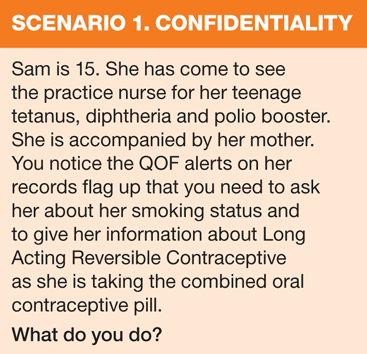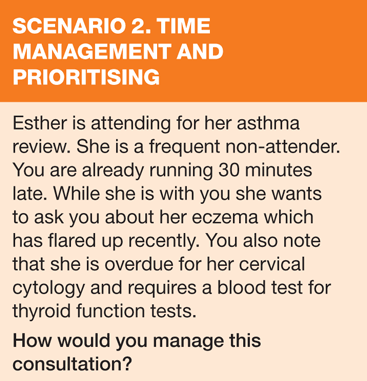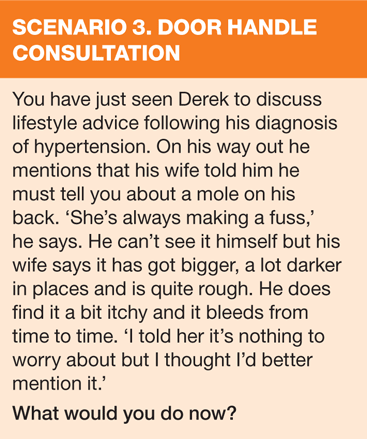Managing the routine consultation
Katherine Hunt
Katherine Hunt
RGN, RM, BSc (Hons)
Practice Nurse
Framlingham Medical Practice, Suffolk
Even the most experienced secondary care nurse would find her first few days in primary care a real eye-opener: the practice nurse needs a whole array of skills in addition to clinical expertise. While each of the topics covered below might warrant an article of its own, our guide sums up the essentials
'You see the thing is, nurse, I’m worried about my Doris. She’s in a real muddle.’
You are already running late and are not making much headway with the Coronary Heart Disease (CHD) review with a delightful, but somewhat garrulous, 80 year old gentleman. Ten minutes into the consultation and you have hardly completed any of the template and you mustn’t forget to offer him a flu vaccination before he goes. The CHD performance indicators are not on his agenda today. Wanting help for his wife’s deteriorating memory is. And he’s just asked for your help.
Undertaking consultations in practice nursing is unique. There are innumerable new skills to learn, targets to reach, time constraints to adhere to. And in addition, we have to face huge expectations from patients who assume we have a comprehensive understanding of all things medical. It is no surprise that nurses new to primary care can feel daunted and out of their depth.
The practice nurse is required to manage individual consultations within a time framework, delivering the best possible evidenced-based care to meet both patient need and the obligations of the General Medical Services (GMS) contract. For those new to the speciality, it would be useful to look at how we can manage the consultation to address those needs.
NEW SKILLS
Nursing in primary care has its own set of specialist skills. We all come into practice nursing with a variety of valuable professional experience and knowledge, but then have to learn a whole range of new skills and practices not previously encountered. Some nurses have never seen the inside of an ear before, or what a normal healthy cervix looks like. Or even how to find it. Such skills, be they treatment room skills, managing chronic disease, becoming competent with vaccination and immunisation, or being able to assess mental health issues, are fundamental to a consultation. The practice nurse, consulting without direct supervision, is fully accountable for her actions and must be ever mindful of the NMC Code and working within the limits of her competence, knowledge and skills for safe and effective practice.1 Patients can expect a huge amount from practice nurses and it’s OK to say ‘I don’t know’ but then signpost them to another colleague or make use of the extensive resources available. We simply can’t know it all.
Training programmes, mentorship, on-line courses and study days develop nursing practice. Together with access to protocols, policies and evidence-based guidance the new practice nurse gains the confidence to carry out practical skills and share knowledge within the consultation. The Royal College of General Practitioners (RCGP) has published a framework for General Practice Nurse competencies, which can be especially useful for new nurses in identifying their learning needs and developing their role.2
TIME MANAGEMENT
Time management is possibly the practice nurse’s biggest challenge. You simply look at your list for the morning and already you know it is going to go wrong. Some consultations clearly haven’t been allocated enough time, others have been inappropriately ‘squeezed in’ (the receptionist tells you the patient just needs some malaria tablets as he’s going on holiday tomorrow, ‘it’ll only take 5 minutes’). It doesn’t account for the ‘while I’m here, nurse’ scenario or the minor casualty who appears mid-morning. The patient that’s on your list for a B12 injection also needs to be offered shingles vaccine, a blood pressure check and instructions for an ACR urine sample for their Chronic Kidney Disease monitoring. No catching up on time there then.
Balancing priorities and time are necessary skills in managing the consultation. However, we realise that with some patients we need to do all we can within their appointment as it may be our only opportunity. Those that frequently ‘DNA’ (do not attend) are a prime example – catch them while you can. Equally, how often do we have patients who open up with a problem that can’t be dealt with in the allotted 10 minutes? Or the patient who turns up for ‘a chat’. We have to accept that there are occasions when we can’t manage our time as well as we would like but, as practice nurses, we also need to prioritise patients’ needs and give the appropriate time to individuals if the situation requires it.
PRIORITISING THE CONSULTATION
Familiarising yourself by reading through the next patient’s notes before you see them can help to determine priorities. However, when a patient attends an appointment the practice nurse becomes a captive audience for anything else the patient may have concerns about for themselves, their children or elderly relatives. Your next appointment may be listed as ‘an ear irrigation’ but when the patient arrives, they also want to ask about a number of other worries especially as it has taken 2 weeks to get the appointment and their list is building up. They may even bring in another family member. Prioritising the patient’s needs isn’t always as straightforward as ‘dealing with the first thing on the list’. For many consultations it is, but there are also times when we have to determine what is most important for that patient at that time. This may be in conflict with times when you are expecting to carry out, for example, a diabetes review and the patient sees this as an opportunity to discuss more burning issues instead, and which bear no resemblance to what is on the diabetic template in front of you. You may be able to undertake some elements of that review within the consultation but then accept that the patient might need to return on another occasion while you deal with their priority.
COMMUNICATION
Developing interpersonal skills of communication and interaction with patients is essential to all nursing, and no less in primary care. We develop a rapport, we listen, we allow patients to off-load their worries and anxieties, we read their body language to try and understand how they are feeling or gain clues by what they are not saying. We gather information, question and reflect back to demonstrate our understanding and we use our communication skills to aid our delivery of the appropriate care through shared decision making with the patient. A great advantage of working within a community is that we often get to know many of our patients and their families well. We build up a relationship, we understand them as people, we get to know how they tick and this improves our consultations with them and aids us in providing the best care. It is a privileged position. Clearly we need to be flexible, treating each patient individually. Indeed, we may have to familiarise ourselves with interpreter services in order to meet the language and communication needs of our patients to provide a safe and appropriate consultation.
CONFIDENTIALITY
Patients have a legal and ethical right to confidentiality and in turn to a relationship built on trust.3 There are occasions when disclosure is necessary but this is beyond the scope of this article.4 During consultations, practice nurses need to be vigilant with data protection issues. This includes the use of computer systems, patient records, making appointments, checking data which patients may be able to oversee, leaving specimens or referral letters on the desk. A patient may ask ‘while I’m here, can you check my mother’s blood test results?’ or ‘has my daughter been in for her smear test?’ Patients often don’t see this as a breach of confidentiality. Indeed, there are also confidentiality issues when seeing patients together, such as for travel health consultations, and practice nurses need to be particularly aware of the potential for breaches of confidentiality.
CONSENT
Much of the consent gained in general practice is through verbal or implied consent. For example, practice nurses usually gain verbal consent from a woman before obtaining a sample for cervical cytology.5 After confirming the patient’s details the procedure is explained, the implications and limitations of the test are discussed, including how test results are received. The patient is given the opportunity to ask questions and offered a chaperone. They are also made aware that they can withdraw consent at any time either before or during the procedure. This constitutes explicit informed consent. However, consent can be implied when a patient rolls up their sleeve before having their blood pressure taken. The NMC states that ‘verbal consent, or consent by implication, will be enough evidence in most cases’. More invasive procedures, such as fitting intrauterine devices, require written consent.6
For patients who lack capacity for consent under the Mental Capacity Act 2005, the Department of Health’s document ‘Reference guide to consent for examination or treatment’ provides excellent guidance and also makes clear the law regarding consent of young people under 18 years of age, including Gillick competence.7
WINDING UP THE CONSULTATION
To bring the consultation to an appropriate close if it becomes unnecessarily prolonged is as much an art as a skill. Most consultations will come to a natural conclusion but it may be that you have to ask the patient to come back on another occasion if they have attended with ‘a shopping list’ of problems. The consultation can be rounded up in a number of ways: summarising the consultation and reflecting back to the patient; agreeing a course of action; providing literature or online resources; offering referral to a colleague if appropriate, or directing to other agencies. Or, when the conversation has somehow turned from medical matters to the benefits of cavity wall insulation, simply walking the patient to the door and opening it. Equally, the practice nurse should resist rushing a consultation and therefore risk making poor clinical decisions as a consequence of being governed by time.
DOOR HANDLE CONSULTATION
There are times, however, when the patient gets to the door, that they finally pluck up courage to reveal or disclose something they are really concerned about or is in fact their primary concern. It may be that the patient just says, ‘Oh, I meant to ask you about XYZ’ – in which case you can direct them to another appointment if that is appropriate. Or, they may say, ‘I’m really worried about my daughter – I think she has an eating disorder’ or ‘I’ve noticed a lump in my breast’. We have to make a judgment on how we deal with each circumstance but we accept that some situations take absolute priority and if it means that we run late for the rest of the morning, so be it. We do right by the patient.
GMS CONTRACT
Quality Outcomes Framework and Enhanced Services
Achieving Qualify and Outcomes Framework (QOF) targets and Enhanced Services (ES) in primary care has an indisputable impact on the practice nurse consultation. Improving patient health through specific indicators for Chronic Disease Management and Public Health priorities is an important aspect of patient care, but the consultation needs to strike a balance between patient need and practice necessity. To ensure performance indicators are met, nurses need to complete practical tasks, provide education, discuss lifestyle changes, offer interventions and, from the practice perspective, to document, record and code correctly. Consultations based on the management of chronic disease naturally lend themselves to addressing patient need and meeting QOF targets. However, a patient attending for a procedure such as the removal of sutures, may also require a number of QOF related activities undertaken. They may simply require a blood pressure recording or be asked about their smoking habits. But it could be that the computer is highlighting the need to discuss erectile dysfunction or dementia screening. Such conversations can be less easy to bring into the consultation. Collecting points aside, practice nurses are in a prime position to take the opportunity to maintain or improve the physical or mental health and wellbeing of each and every patient encounter and ‘make every contact count’.8 Alternatively, we can become so focused on the requirements of QOF and enhanced services, responding to the barrage of emails, tasks and notifications from ‘management’ to ensure as many ‘points’ are collected that we could lose sight of the patient and their needs, or fail to have the sensitivity to deal with certain issues appropriately.
IT SKILLS AND RECORD KEEPING
Many computer systems in general practice are template-based and allow consultations to be recorded using a ‘check list’ or tools to ensure accuracy, correct coding and to avoid omissions in documentation. Accurate, contemporaneous record keeping is paramount to safe professional practice and the addition of clear and concise free text is often necessary to ensure complete documentation of the consultation. However, practice nurses need to adapt their skills so they don’t become fully focused on the computer, slavishly working through a template and almost ignoring the person sitting next to them. The patient should remain central to the consultation and the practice nurse’s body language needs to reflect that.
SUMMARY
Practice nurse consultations are rarely straightforward. Our aim is to meet patient need, build up extensive skills and knowledge, improve public health, signpost appropriately, achieve targets, and keep the bosses happy – all within a set time period. It is achievable, although some days it doesn’t feel like that. But it’s what practice nursing is all about. Today it’s to help that elderly gentleman cope with his wife’s dementia. He can always come back for his CHD check next week.
REFERENCES
1. Nursing and Midwifery Council. The code: Standards of conduct, performance
and ethics for nurses and midwives. London: NMC, 2008.
2. RCGP General Practice Foundation. General Practice Nurse Competencies. RCGP, 2012 Available at: http://www.rcgp.org.uk/membership/practice-teams-nurses-and-managers/~/media/Files/Membership/GPF/RCGP-GPF-Nurse-Competencies.ashx
3. Nursing and Midwifery Council. Confidentiality. 2013 Available at:
http://www.nmc-uk.org/nurses-and-midwives/advice-by-topic/a/advice/confidentiality/
4. Lowth, M. Confidentiality in the Modern NHS: Part 1 Practice Nurse. 2013; 43 (10) 48
5. Royal College of Nursing. Cervical Screening. RCN Guidance for good practice. London, 2013 Available at: https://www.rcn.org.uk/__data/assets/pdf_file/0007/78730/003105.pdf
6. Nursing and Midwifery Council. Consent. 2013. Available at: http://www.nmc-uk.org/Nurses-and-midwives/Regulation-in-practice/Regulation-in-Practice-Topics/consent/
7. Department of Health. Reference guide to consent for examination or treatment. 2009 Available at: https://www.gov.uk/government/uploads/system/uploads/attachment_data/file/138296/dh_103653__1_.pdf
8. Department of Health. Compassion in Practice. Nursing, Midwifery and Care Staff. Our vision and strategy. NHS Commissioning Board, 2012 Available at: http://www.england.nhs.uk/wp-content/uploads/2012/12/compassion-in-practice.pdf
Related articles
View all Articles



